

The Algorithm That Tells the Boss Who Might Quit. Employers want to know who has one foot out the door.
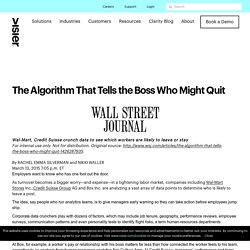
As turnover becomes a bigger worry—and expense—in a tightening labor market, companies including Wal-Mart Stores Inc. ,Credit Suisse Group AG and Box Inc. are analyzing a vast array of data points to determine who is likely to leave a post. The idea, say people who run analytics teams, is to give managers early warning so they can take action before employees jump ship. Corporate data crunchers play with dozens of factors, which may include job tenure, geography, performance reviews, employee surveys, communication patterns and even personality tests to identify flight risks, a term human-resources departments sometimes use for people likely to leave. The data often reveal a complex picture of what motivates workers to stay—and what causes them to look elsewhere.
Human Resource? Oh, You Mean People! Making sure people are engaged at work is a massive business opportunity, and is one that is too big to be left solely in the hands of HR.
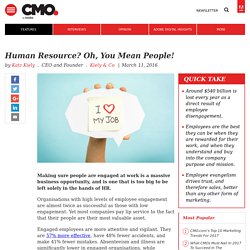
Organisations with high levels of employee engagement are almost twice as successful as those with low engagement. Yet most companies pay lip service to the fact that their people are their most valuable asset. Engaged employees are more attentive and vigilant. The GTCI Index - GTCI Report 2018. Singapore (2nd) is the flag bearer of performance in the region.

Next comes Australia (11th) and New Zealand (12th). Japan (20th) has a solid overall performance, although its talent competitiveness is held back by a low performance in the Attract pillar where even middle-income countries such as Malaysia attract more foreign talent. Indonesia (77th) has a long way to go to catch up on all the pillars, yet the country has strong Employability of its domestic population—and it is increasingly perceived by business leaders as being attractive to high-skilled people. Thailand (70th) also needs to catch up across the different pillars, but it does boast a relatively better performance in the Enable pillar—particularly driven by the Market Landscape and the Business and Labour Landscape.
Driving Retention Using Talent Data and Analytics. Even with the advancements in talent management, organizations often grapple with decoding the basics, for example, employee attrition.
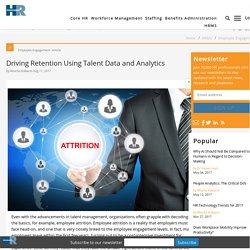
Employee attrition is a reality that employers must face head-on, and one that is very closely linked to the employee engagement levels. In fact, many employees leave within the first few years, turning out to be a cost-intensive investment for various reasons. HR professionals are left wondering what went wrong with the employee experience. Little do they realize that they have the answer right before them, in the form of the humongous wealth of data collected from the very people who have left.
So the question is, where should HR dig into, to decode the attrition challenge? The problem with talent analytics is that HR is using it mainly for retrospection, i.e. for acting on the results. The Key To Retention Is Care. Employee Retention Strategies You Can Start Today (Part 1) - Social Talent. Posted by Jon Hainstock Employee retention is one of the key aspects to a company’s success.
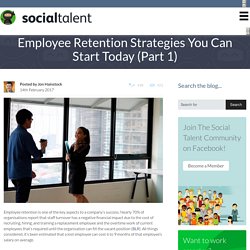
Nearly 70% of organisations report that staff turnover has a negative financial impact due to the cost of recruiting, hiring, and training a replacement employee and the overtime work of current employees that’s required until the organisation can fill the vacant position (BLR). All things considered, it’s been estimated that a lost employee can cost 6 to 9 months of that employee’s salary on average.
Employee turnover is a major problem, and there are many factors at work, including generational factors, the economy, sweeping changes in the workplaces, and more.Learning the following actionable strategies will help you reduce employee turnover, and retain the talent you need to run your company. 1. We all know that employees need feedback to improve and to do their best work – both positive, and constructive advice. Your action step: Give each employee one positive bit of feedback each week. 2.
Employee Retention Strategies You Can Start Today (Part 2) - Social Talent. Effective Employee Retention Strategies. It's every manager's nightmare: One of your best employees resigns out of the blue.
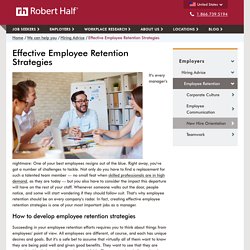
How to Reinvent Retention Strategies That Work. Retention strategies for talent should be every company’s priority.

It’s something that simply cannot slip past your radar. Competition is stiff, the market is actively looking for talented individuals and you have some of them. You have to be on your guard otherwise you’ll quickly watch your top resources slip away leaving behind a huge void in your talent pool. #RH : Le télétravail, moteur de croissance ? L’exemple de Trello et d’une politique RH qui fait des émules - Maddyness. Alors que Trello vient tout juste d’annoncer son acquisition par Altassian pour 425 millions de dollars, retour sur la politique RH de la startup avec Elizabeth Hall, VP “people” de la jeune pousse, qui gère 100 collaborateurs installés aux quatre coins du monde.

En France, le sujet fait débat. Le télétravail outil d’une meilleure performance individuelle ou aubaine pour employés malhonnêtes ? La seconde option semble plus être celle à laquelle souhaitent croire les managers ancrés dans un mode de fonctionnement daté, alors que les nouvelles entreprises, plus agiles, et les nouveaux managers qui les accompagnent utilisent volontiers cette méthode de fonctionnement comme un outil Rh qui sert à la fois au bien-être de l’employé et à l’entreprise qui l’emploie. Selon une étude Randstad de 2016, 64% des salariés français sont favorables au télétravail quand, dans les faits, seuls 16% se sont vus proposer par leur employeur ce mode de fonctionnement, qu’il soit occasionnel ou non.